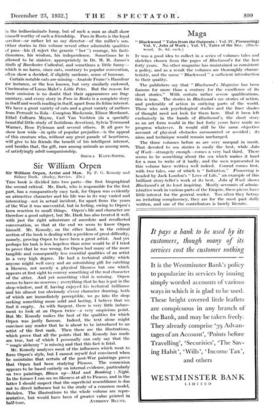Sir William Orpen
Sir William Orpen, Artist and Man. By P. G. Konody and Sidney Dark. (Seeley, Service. 25s.)
Tms book is divided into two parts—the first biographical the second critical. Mr. Dark, who is responsible for the first part, has a comparatively easy task, for Orpen was evidently an attractive character and his life was in its way varied and interesting—not in actual incident, for apart from the years of the War it was uneventful, but in feeling, owing to Orpen's keen reaction to small things. Orpen's life and character arc therefore a good subject, but Mr. Dark has also treated it well, with just the right admixture of anecdote and recollected conversation, so that at the end we seem to know Orpen himself. Mr. Konody, on the other hand, in the critical section of the book is dealing with a problem of great difficulty, namely, proving Orpen to have been a great artist. And yet perhaps his task is less hopeless than mine would be if I tried to prove that he was wrong, for Orpen had many of the more tangible and consequently less essential qualities of an artist in a very high degree. He had a technical ability which anyone might well envy and all astonishing gift for catching a likeness, not merely a physical likeness but one which appears at first sight to convey something of the real character of the sitter. And yet something vital is missing. Orpen seems to have no reserves ; everything that he has is put in the shop-window, and if, having enjoyed his technical brilliance and his almost too obviously c!ever character drawing, both of which are immediately perceptible, we go into the shop seeking something more solid and lasting, I believe that we find it empty. As with Sargent, there is very little induce- ment to look at an Orpen twice—a very suspicious point. But Mr. Konody makes the best of the qualities for which Orpen was justly famous: Indeed, the text alone might convince any reader that he is about to be introduced to an artist of the first rank. Then there are the illustrations, which prove that all the points that Mr. Konody has made are true, but of which I personally can only say that the "magic alchemy" is missing and that this fact is fatal. Mr. Konody analyses most of the influences which went to form Orpen's style, but I cannot myself feel convinced when he maintains that certain of the post-War paintings prove that Orpen had been studying Picasso. The connexion appears to be based entirely on internal evidence, particularly on two paintings, Blown up—Mad and Bombing : Night. In the former I can see no likeness at all to Picasso, and in the latter I should suspect that the superficial resemblance is due not to direct influence but to the study of a common model, Steinlen. The illustrations to the whole volume are repre- sentative, but would have been of greater value printed in


























 Previous page
Previous page